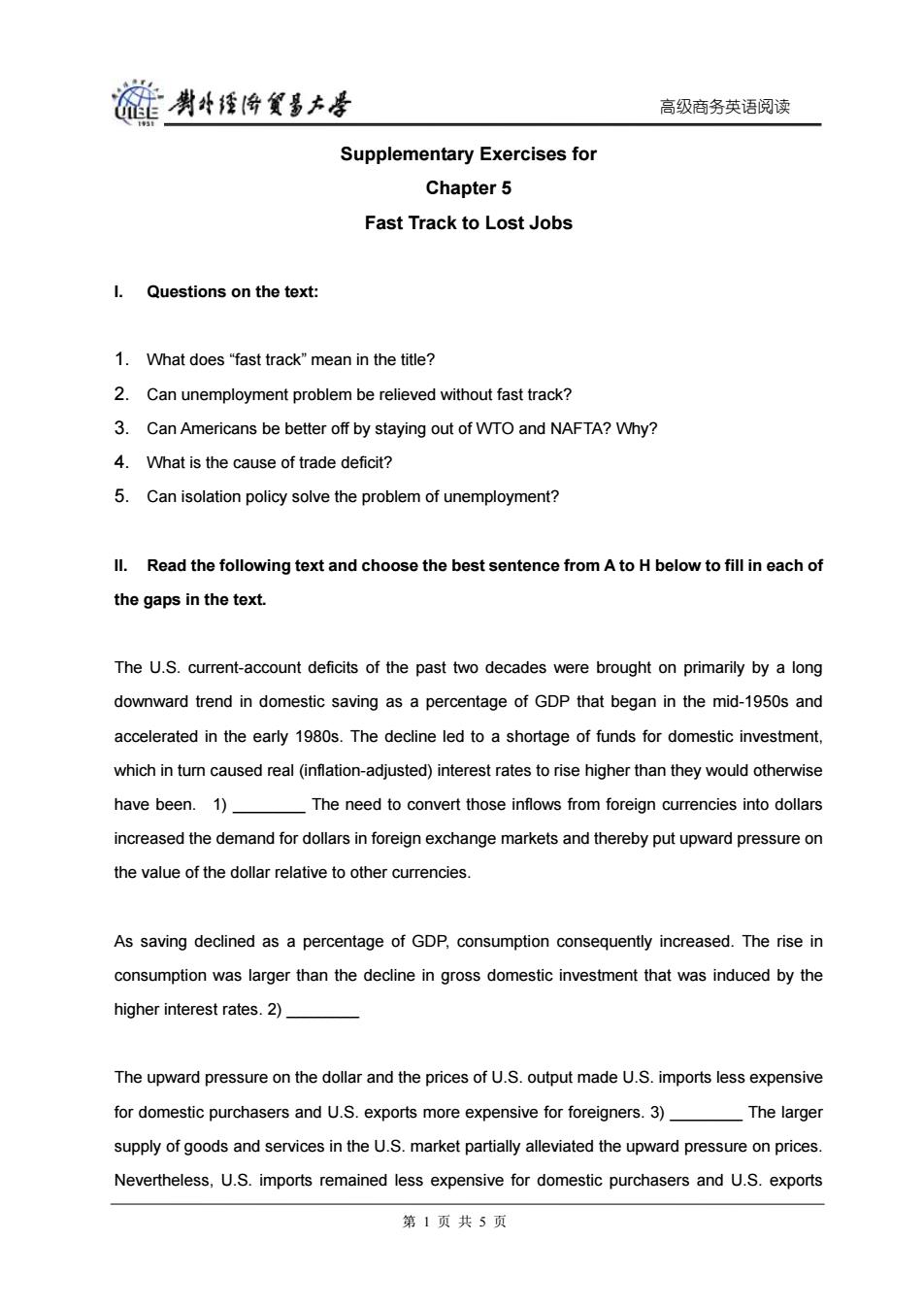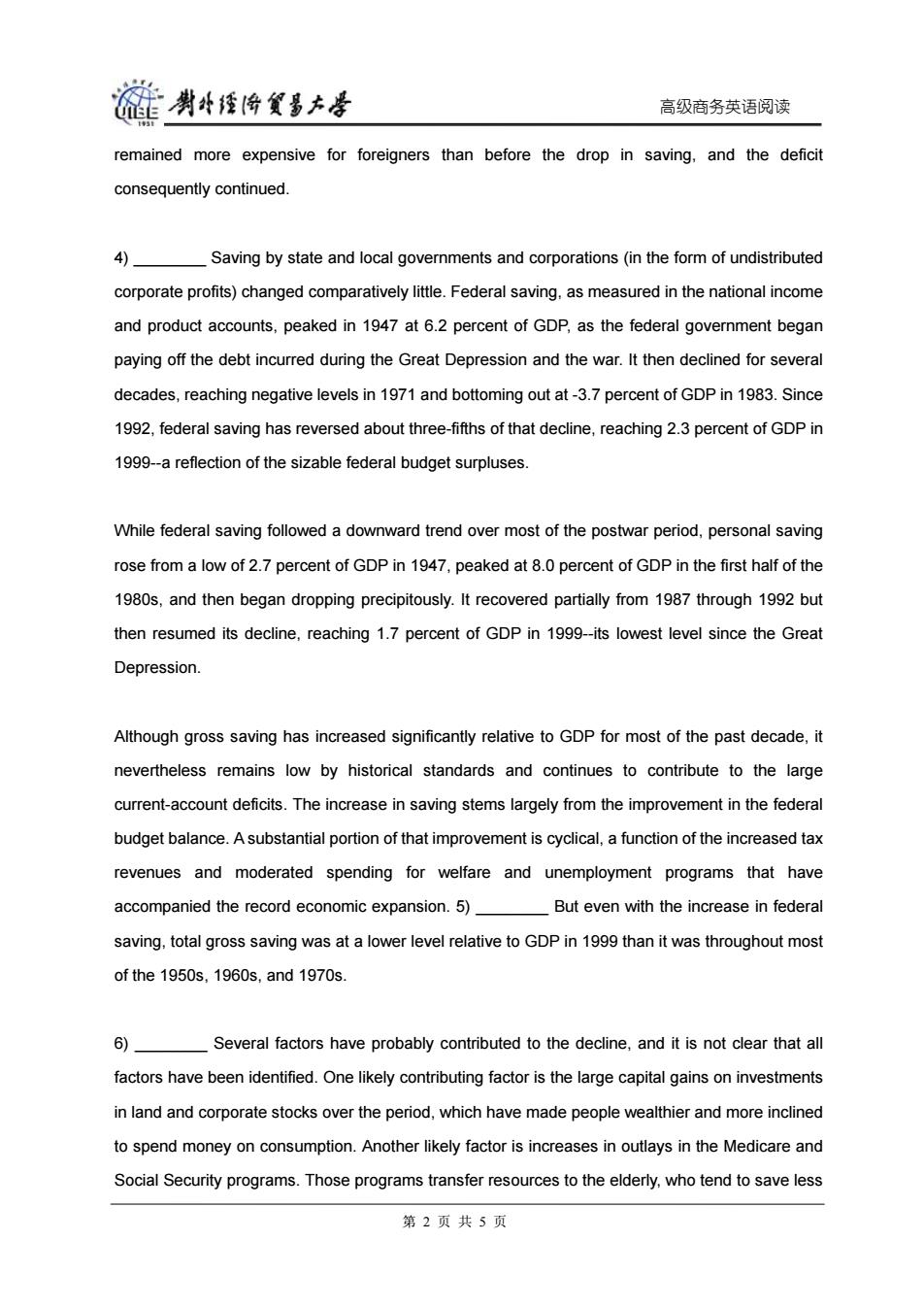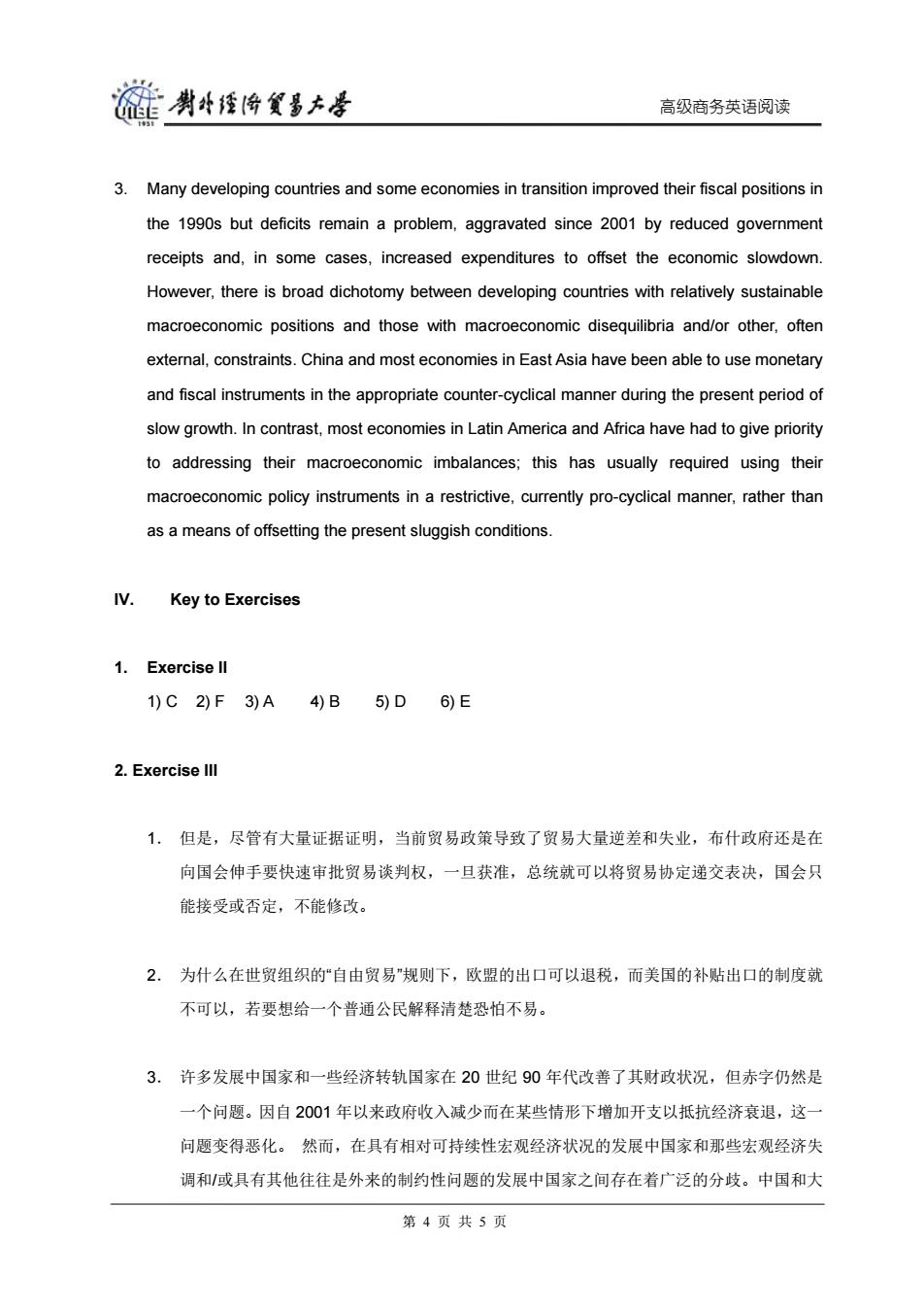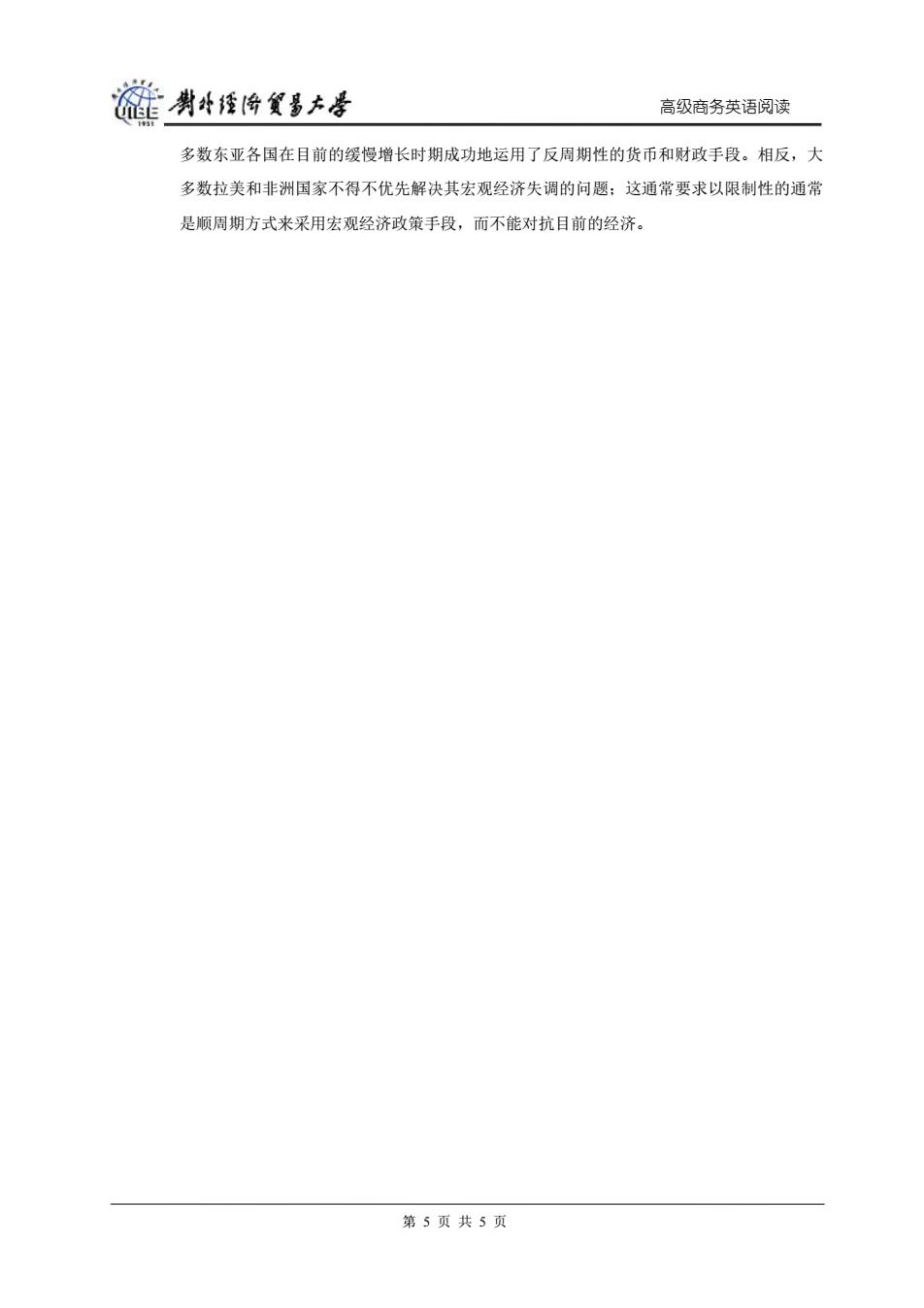
链典4矮降贸多大 高级商务英语阅读 Supplementary Exercises for Chapter 5 Fast Track to Lost Jobs . Questions on the text: 1.What does"fast track"mean in the title? 2.Can unemployment problem be relieved without fast track? 3.Can Americans be better off by staying out of WTO and NAFTA?Why? 4.What is the cause of trade deficit? 5.Can isolation policy solve the problem of unemployment? Il.Read the following text and choose the best sentence from A to H below to fill in each of the gaps in the text. The U.S.current-account deficits of the past two decades were brought on primarily by a long downward trend in domestic saving as a percentage of GDP that began in the mid-1950s and accelerated in the early 1980s.The decline led to a shortage of funds for domestic investment, which in turn caused real(inflation-adjusted)interest rates to rise higher than they would otherwise have been.1)The need to convert those inflows from foreign currencies into dollars increased the demand for dollars in foreign exchange markets and thereby put upward pressure on the value of the dollar relative to other currencies. As saving declined as a percentage of GDP,consumption consequently increased.The rise in consumption was larger than the decline in gross domestic investment that was induced by the higher interest rates.2) The upward pressure on the dollar and the prices of U.S.output made U.S.imports less expensive for domestic purchasers and U.S.exports more expensive for foreigners.3)The larger supply of goods and services in the U.S.market partially alleviated the upward pressure on prices. Nevertheless,U.S.imports remained less expensive for domestic purchasers and U.S.exports 第1页共5页
高级商务英语阅读 Supplementary Exercises for Chapter 5 Fast Track to Lost Jobs I. Questions on the text: 1. What does “fast track” mean in the title? 2. Can unemployment problem be relieved without fast track? 3. Can Americans be better off by staying out of WTO and NAFTA? Why? 4. What is the cause of trade deficit? 5. Can isolation policy solve the problem of unemployment? II. Read the following text and choose the best sentence from A to H below to fill in each of the gaps in the text. The U.S. current-account deficits of the past two decades were brought on primarily by a long downward trend in domestic saving as a percentage of GDP that began in the mid-1950s and accelerated in the early 1980s. The decline led to a shortage of funds for domestic investment, which in turn caused real (inflation-adjusted) interest rates to rise higher than they would otherwise have been. 1) ________ The need to convert those inflows from foreign currencies into dollars increased the demand for dollars in foreign exchange markets and thereby put upward pressure on the value of the dollar relative to other currencies. As saving declined as a percentage of GDP, consumption consequently increased. The rise in consumption was larger than the decline in gross domestic investment that was induced by the higher interest rates. 2) ________ The upward pressure on the dollar and the prices of U.S. output made U.S. imports less expensive for domestic purchasers and U.S. exports more expensive for foreigners. 3) ________ The larger supply of goods and services in the U.S. market partially alleviated the upward pressure on prices. Nevertheless, U.S. imports remained less expensive for domestic purchasers and U.S. exports 第 1 页 共 5 页

碰肖经海食昌大是 高级商务英语阅读 remained more expensive for foreigners than before the drop in saving,and the deficit consequently continued. 4) Saving by state and local governments and corporations(in the form of undistributed corporate profits)changed comparatively little.Federal saving,as measured in the national income and product accounts,peaked in 1947 at 6.2 percent of GDP,as the federal government began paying off the debt incurred during the Great Depression and the war.It then declined for several decades,reaching negative levels in 1971 and bottoming out at-3.7 percent of GDP in 1983.Since 1992,federal saving has reversed about three-fifths of that decline,reaching 2.3 percent of GDP in 1999--a reflection of the sizable federal budget surpluses. While federal saving followed a downward trend over most of the postwar period,personal saving rose from a low of 2.7 percent of GDP in 1947,peaked at 8.0 percent of GDP in the first half of the 1980s,and then began dropping precipitously.It recovered partially from 1987 through 1992 but then resumed its decline,reaching 1.7 percent of GDP in 1999--its lowest level since the Great Depression. Although gross saving has increased significantly relative to GDP for most of the past decade,it nevertheless remains low by historical standards and continues to contribute to the large current-account deficits.The increase in saving stems largely from the improvement in the federal budget balance.A substantial portion of that improvement is cyclical,a function of the increased tax revenues and moderated spending for welfare and unemployment programs that have accompanied the record economic expansion.5) But even with the increase in federal saving,total gross saving was at a lower level relative to GDP in 1999 than it was throughout most of the 1950s,1960s,and 1970s. 6) Several factors have probably contributed to the decline,and it is not clear that all factors have been identified.One likely contributing factor is the large capital gains on investments in land and corporate stocks over the period,which have made people wealthier and more inclined to spend money on consumption.Another likely factor is increases in outlays in the Medicare and Social Security programs.Those programs transfer resources to the elderly,who tend to save less 第2页共5页
高级商务英语阅读 remained more expensive for foreigners than before the drop in saving, and the deficit consequently continued. 4) ________ Saving by state and local governments and corporations (in the form of undistributed corporate profits) changed comparatively little. Federal saving, as measured in the national income and product accounts, peaked in 1947 at 6.2 percent of GDP, as the federal government began paying off the debt incurred during the Great Depression and the war. It then declined for several decades, reaching negative levels in 1971 and bottoming out at -3.7 percent of GDP in 1983. Since 1992, federal saving has reversed about three-fifths of that decline, reaching 2.3 percent of GDP in 1999--a reflection of the sizable federal budget surpluses. While federal saving followed a downward trend over most of the postwar period, personal saving rose from a low of 2.7 percent of GDP in 1947, peaked at 8.0 percent of GDP in the first half of the 1980s, and then began dropping precipitously. It recovered partially from 1987 through 1992 but then resumed its decline, reaching 1.7 percent of GDP in 1999--its lowest level since the Great Depression. Although gross saving has increased significantly relative to GDP for most of the past decade, it nevertheless remains low by historical standards and continues to contribute to the large current-account deficits. The increase in saving stems largely from the improvement in the federal budget balance. A substantial portion of that improvement is cyclical, a function of the increased tax revenues and moderated spending for welfare and unemployment programs that have accompanied the record economic expansion. 5) ________ But even with the increase in federal saving, total gross saving was at a lower level relative to GDP in 1999 than it was throughout most of the 1950s, 1960s, and 1970s. 6) ________ Several factors have probably contributed to the decline, and it is not clear that all factors have been identified. One likely contributing factor is the large capital gains on investments in land and corporate stocks over the period, which have made people wealthier and more inclined to spend money on consumption. Another likely factor is increases in outlays in the Medicare and Social Security programs. Those programs transfer resources to the elderly, who tend to save less 第 2 页 共 5 页

能男牛经降贸多大 高级商务英语阅读 than other age groups do.Still another possible factor is the development and spread of new credit vehicles,such as credit cards and home-equity loans,that have eased previous constraints on consumption,but their significance is not entirely clear. Other factors appear not to have contributed to the decline in personal saving or to have been much less significant than capital gains and spending increases in Medicare and Social Security. Those other factors include changes in interest rates,changes in the growth rate of the economy (apart from any effects that expected future changes in growth rates might have on capital gains in the stock market),and changes in the demographic composition of the population(that is,changes in the proportion of the population in age groups that typically save a smaller portion of income). A.As a result,imports rose and exports fell relative to what they would otherwise have been. causing a chronic current-account deficit that equaled the net inflow of foreign investment. B.Declines in federal saving and personal saving accounted for most of the fall in gross saving over the post-World War Il period. C.The higher interest rates attracted inflows of financial capital from abroad. D.Some of the decline in personal saving may be cyclical as well. E.Economists have devoted considerable research to explaining the decline in personal saving over the past two decades,but no single theory examined so far can completely account for it. F.As a result,total domestic demand for goods and services--consumption plus investment--increased,putting upward pressure on the prices of U.S.output. Ill.E-C Translation: 1.Yet despite substantial evidence that current trade policies have resulted in massive trade deficits and job losses,the Bush Administration is pressing Congress for "fast track"trade negotiating authority,by which the President could submit trade agreements to Congress for a yes or no vote without amendment. 2.It is hard to explain to an ordinary citizen or company why the EU rebates are allowable under the WTO's"free trade"rules while the U.S.system for subsidizing exports is not. 第3页共5页
高级商务英语阅读 than other age groups do. Still another possible factor is the development and spread of new credit vehicles, such as credit cards and home-equity loans, that have eased previous constraints on consumption, but their significance is not entirely clear. Other factors appear not to have contributed to the decline in personal saving or to have been much less significant than capital gains and spending increases in Medicare and Social Security. Those other factors include changes in interest rates, changes in the growth rate of the economy (apart from any effects that expected future changes in growth rates might have on capital gains in the stock market), and changes in the demographic composition of the population (that is, changes in the proportion of the population in age groups that typically save a smaller portion of income). A. As a result, imports rose and exports fell relative to what they would otherwise have been, causing a chronic current-account deficit that equaled the net inflow of foreign investment. B. Declines in federal saving and personal saving accounted for most of the fall in gross saving over the post-World War II period. C. The higher interest rates attracted inflows of financial capital from abroad. D. Some of the decline in personal saving may be cyclical as well. E. Economists have devoted considerable research to explaining the decline in personal saving over the past two decades, but no single theory examined so far can completely account for it. F. As a result, total domestic demand for goods and services--consumption plus investment--increased, putting upward pressure on the prices of U.S. output. III. E-C Translation: 1. Yet despite substantial evidence that current trade policies have resulted in massive trade deficits and job losses, the Bush Administration is pressing Congress for “fast track” trade negotiating authority, by which the President could submit trade agreements to Congress for a yes or no vote without amendment. 2. It is hard to explain to an ordinary citizen or company why the EU rebates are allowable under the WTO’s “free trade” rules while the U.S. system for subsidizing exports is not. 第 3 页 共 5 页

碰男华经海贸多大学 高级商务英语阅读 3.Many developing countries and some economies in transition improved their fiscal positions in the 1990s but deficits remain a problem,aggravated since 2001 by reduced government receipts and,in some cases,increased expenditures to offset the economic slowdown. However,there is broad dichotomy between developing countries with relatively sustainable macroeconomic positions and those with macroeconomic disequilibria and/or other,often external,constraints.China and most economies in East Asia have been able to use monetary and fiscal instruments in the appropriate counter-cyclical manner during the present period of slow growth.In contrast,most economies in Latin America and Africa have had to give priority to addressing their macroeconomic imbalances;this has usually required using their macroeconomic policy instruments in a restrictive,currently pro-cyclical manner,rather than as a means of offsetting the present sluggish conditions IV. Key to Exercises 1.Exercise ll 1)C2)F3)A4)B 5)D6)E 2.Exercise lll 1.但是,尽管有大量证据证明,当前贸易政策导致了贸易大量逆差和失业,布什政府还是在 向国会伸手要快速审批贸易谈判权,一旦获准,总统就可以将贸易协定递交表决,国会只 能接受或否定,不能修改。 2.为什么在世贸组织的“自由贸易”规则下,欧盟的出口可以退税,而美国的补贴出口的制度就 不可以,若要想给一个普通公民解释清楚恐怕不易。 3.许多发展中国家和一些经济转轨国家在20世纪90年代改善了其财政状况,但赤字仍然是 一个问题。因自2001年以来政府收入减少而在某些情形下增加开支以抵抗经济衰退,这一 问题变得恶化。然而,在具有相对可持续性宏观经济状况的发展中国家和那些宏观经济失 调和/或具有其他往往是外来的制约性问题的发展中国家之间存在着广泛的分歧。中国和大 第4页共5页
高级商务英语阅读 3. Many developing countries and some economies in transition improved their fiscal positions in the 1990s but deficits remain a problem, aggravated since 2001 by reduced government receipts and, in some cases, increased expenditures to offset the economic slowdown. However, there is broad dichotomy between developing countries with relatively sustainable macroeconomic positions and those with macroeconomic disequilibria and/or other, often external, constraints. China and most economies in East Asia have been able to use monetary and fiscal instruments in the appropriate counter-cyclical manner during the present period of slow growth. In contrast, most economies in Latin America and Africa have had to give priority to addressing their macroeconomic imbalances; this has usually required using their macroeconomic policy instruments in a restrictive, currently pro-cyclical manner, rather than as a means of offsetting the present sluggish conditions. IV. Key to Exercises 1. Exercise II 1) C 2) F 3) A 4) B 5) D 6) E 2. Exercise III 1. 但是,尽管有大量证据证明,当前贸易政策导致了贸易大量逆差和失业,布什政府还是在 向国会伸手要快速审批贸易谈判权,一旦获准,总统就可以将贸易协定递交表决,国会只 能接受或否定,不能修改。 2. 为什么在世贸组织的“自由贸易”规则下,欧盟的出口可以退税,而美国的补贴出口的制度就 不可以,若要想给一个普通公民解释清楚恐怕不易。 3. 许多发展中国家和一些经济转轨国家在 20 世纪 90 年代改善了其财政状况,但赤字仍然是 一个问题。因自 2001 年以来政府收入减少而在某些情形下增加开支以抵抗经济衰退,这一 问题变得恶化。 然而,在具有相对可持续性宏观经济状况的发展中国家和那些宏观经济失 调和/或具有其他往往是外来的制约性问题的发展中国家之间存在着广泛的分歧。中国和大 第 4 页 共 5 页

链典4矮降贸事大 高级商务英语阅读 多数东亚各国在目前的缓慢增长时期成功地运用了反周期性的货币和财政手段。相反,大 多数拉美和非洲国家不得不优先解决其宏观经济失调的问题:这通常要求以限制性的通常 是顺周期方式来采用宏观经济政策手段,而不能对抗目前的经济。 第5页共5页
高级商务英语阅读 多数东亚各国在目前的缓慢增长时期成功地运用了反周期性的货币和财政手段。相反,大 多数拉美和非洲国家不得不优先解决其宏观经济失调的问题;这通常要求以限制性的通常 是顺周期方式来采用宏观经济政策手段,而不能对抗目前的经济。 第 5 页 共 5 页